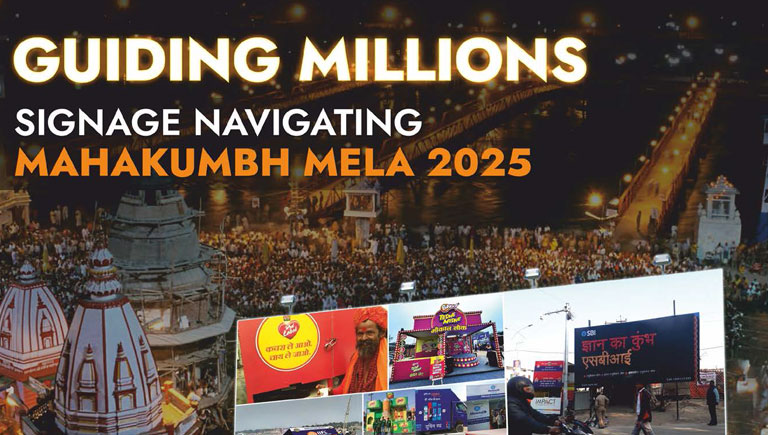HOW INNOVATIVE SIGNAGE TRANSFORMED THE WORLD’S LARGEST GATHERING MAHA KUMBH MELA 2025
In the early morning darkness by the holy Ganges River, 78-year-old Lakshmi Devi holds a small plastic card with colorful pictures. She never
learned to read, but she can easily find her way through the huge tent city where millions of people are staying.
“This is my third Kumbh Mela,” she says, pointing to the pictures on her card that match the big signs above the crowds. “But this is the first
time I haven’t had to ask anyone for directions. The pictures show me exactly where to go.”
Kumbh Mela stands as the world’s largest religious gathering, drawing millions of devotees from across India and beyond. This sacred festival, deeply rooted in spiritual traditions, is a unique confluence of faith, devotion, and cultural heritage. Held every twelve years at one of the four holy sites- rayagraj, Haridwar, Nashik, and Ujjain—the event is a grand spectacle of rituals, prayers, and collective spiritual awakening. The festival holds immense significance for Hindus, who believe that taking a holy dip in the sacred rivers during this period cleanses them of sins and paves the way for salvation. The sheer scale of Kumbh Mela transforms the host city into a vast, temporary township, complete with tented accommodations, food stalls, health facilities, and elaborate arrangements for religious discourses and
ceremonies.
TYPES OF KUMBH MELA
MAHA KUMBH MELA – Occurs once every 144 years in Prayagraj.
PURNA KUMBH MELA – Held every 12 years at all four sacred sites.
ARDH KUMBH MELA – Celebrated every six years in Prayagraj and Haridwar.
MAGH MELA – An annual event in Prayagraj during January-February.
The origins of Kumbh Mela date back centuries, with its traditions intertwined with mythology and religious scriptures. Over time, it has evolved into a well-organized, large-scale event that not only attracts sadhus, saints,
and spiritual seekers but also curious travelers, photographers, and researchers interested in its social and cultural dynamics. The atmosphere is charged with an undeniable energy—thousands of ascetics meditating along the riverbanks, massive processions led by akharas (religious sects), and the continuous chanting of hymns create an aura of devotion that is unmatched. However, this grand congregation also presents immense logistical challenges, requiring meticulous planning to ensure the smooth movement of people, resources, and services.
One of the biggest hurdles in managing an event of this magnitude is crowd
control. With millions of pilgrims arriving from different regions, languages, and backgrounds, navigating the sprawling fairgrounds can be overwhelming. Many attendees are elderly devotees or first-time visitors unfamiliar with the vast layout of the Mela. Moreover, the high density of people in certain areas, particularly at bathing ghats and religious venues, increases the risk of congestion, confusion, and even stampedes. Given the dynamic nature of the event, with temporary structures, makeshift roads, and shifting congregation points, ensuring that everyone finds their way safely is a significant challenge.
In such an environment, signage plays an indispensable role. Clearly visible,
strategically placed signs help pilgrims locate essential landmarks such as
bathing areas, temples, camps, food stalls, restrooms, medical aid centers, and
security checkpoints. Directional signage not only aids navigation but also prevents overcrowding in sensitive zones by guiding people toward alternate routes. Safety signage ensures that emergency services are easily accessible, while informational boards help visitors stay aware of rituals, event schedules, and important announcements. Given the linguistic diversity of the attendees, signage must also cater to multiple languages, making symbols and pictograms crucial for universal understanding.
As Kumbh Mela continues to grow in scale, so do the innovations in its management. The year 2025 marks a new chapter in the festival’s history, with advanced technological solutions enhancing traditional signage. Digital screens displaying real-time updates, GPS-enabled smart signboards, QR-code-integrated maps, and even AI-powered crowd control signage are being incorporated to streamline navigation and improve visitor experience. These advancements not only make information more accessible but also enable authorities to adapt dynamically to crowd movements, ensuring safety and
efficiency.
The evolution of signage at Kumbh Mela reflects a broader shift in event
management—where tradition meets technology to create a more organized,
safe, and enriching experience for millions of devotees. As preparations for
Kumbh Mela 2025 continue, the role of signage remains at the heart of its logistical planning, shaping the way pilgrims engage with the festival and ensuring that their spiritual journey is smooth and memorable.




